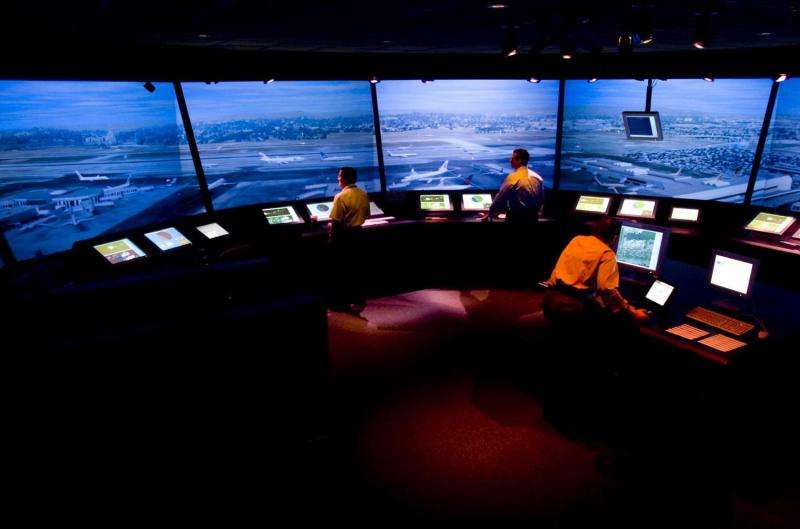360-degree airport simulator tests the future of air traffic control

Heading home for the holidays may fill you with joy, as well as a little dread at the thought of the complexities of air travel at one of the busiest times of the year. The good news is that NASA is working on new technologies and concepts in air traffic management that will not only provide some relief from holiday travel headaches, but increase the efficiency, safety and environmental friendliness of air transportation.
Today, researchers are testing these new tools at FutureFlight Central, a comprehensive, 360-degree simulation of an air traffic control tower at NASA Ames Research Center in California's Silicon Valley.
"FutureFlight Central is uniquely equipped to recreate the experience of being in any air traffic control tower, at any airport, with any amount of traffic," said Fay Chinn, FutureFlight's facility manager.
Virtually every air traffic control tower in the United States uses some form of NASA-developed technology, and any of them can be recreated here. Inside the simulator, you could believe you were in the control tower of your local airport … until another location appears outside the windows.
The view is recreated on 12 projection screens from high-resolution aerial photography, elevation data and close-up digital photography. In FutureFlight's simulated world of aviation, planes taxi along the runway, take off, and land just as they would at a real airport. These simulations are created from a database that includes 3-D modeling of more than a hundred aircraft and ground vehicles. For researchers in other fields, FutureFlight can even take them virtually to the surface of Mars.
Optimizing Air Traffic Management at FutureFlight Central
NASA, the Federal Aviation Administration (FAA), and industry partners at airports and airlines are collaborating on the next generation of systems to manage air traffic from gate to gate, relying on FutureFlight to let real pilots and air traffic controllers test their new developments early in the design phase.
"We can change the air traffic levels. We can introduce different weather conditions. We can introduce different technologies and different configurations, and play with all of those and research them in this facility," said Savvy Verma, an Ames aerospace researcher.
One newly developed component features software and other technology that will automate the process of communication between different aircraft controllers. This work is part of the Airspace Technology Demonstration-2 (ATD-2) project, managed by NASA Ames.
Today, communication between controllers in charge of telling planes when to push back from the gate and those handling their take-off and insertion into the flight stream is analog and limited. Without an automatic system for sharing information, they are obliged to coordinate the timing of these maneuvers by phone. Lags in communication here can lead to unused take-off windows, and other delays.
"We are not just researching how to improve airport surface traffic on the ground," said Kathy Lee, deputy division chief of the Aviation Systems Division at NASA Ames. "though that's what you experience viscerally as a passenger. But you may not be aware of what happens in the air. If there's bad weather and a lot of flights are rerouted around it, you may not know you're being rerouted. Our tools will help increase efficiency during this part of your trip too."
During a test at FutureFlight, data is recorded on all elements of the simulated airspace—including voice transmissions between pilots, and summary statistics of aircraft activity, such as taxi times, runway waits and departure rates—allowing NASA researchers to replay an entire simulation run and examine how their tools performed in the hands of real users. Their analyses of these different steps in the process allow them to recommend ways to optimize the routing of planes, the timing of their movements, and the communication among different parties responsible for making a hectic airport move like clockwork.
NASA's new air traffic management tools are demonstrated in a series of Airspace Technology Demonstrations (ATDs), before being handed over to the FAA. ATD-2's tools for automating flight departure communications, among others, will undergo a major simulation test in March 2017.
"This is the first time we're integrating several pieces of research, and we expect them to graduate to testing in the field, starting in September 2017. We expect to begin seeing the impact at the first airports involved soon thereafter," Verma said.
Provided by NASA





















